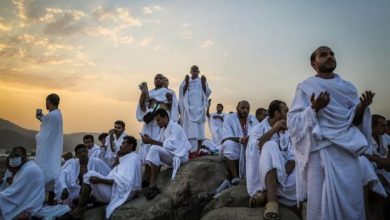Hajj 2019: How to perform the Muslim pilgrimage
 Thousands of Muslims in early July began arriving in Saudi Arabia via the Mecca Road Initiative for the annual Hajj pilgrimage, which begins on August 9, and around three million more – the annual average – are set to follow in the coming weeks.
Thousands of Muslims in early July began arriving in Saudi Arabia via the Mecca Road Initiative for the annual Hajj pilgrimage, which begins on August 9, and around three million more – the annual average – are set to follow in the coming weeks.
Hajj begins in Mecca, Islam’s holiest city, and resumes at different sites in its vicinity, with several rituals performed along the way. It usually takes between four and six days to complete.
The fifth pillar of Islam, Hajj is a mandatory religious duty for Muslims. Adult Muslims are required to perform Hajj at least once in a lifetime if they have the physical and financial ability to do so.
A basic how-to guide for performing Hajj
Entering into a state of ihram is the first step in performing Hajj. In order to do this, pilgrims have to recite their intention to perform Hajj, called the talbiyah, which prepares the soul, mind, and body for the pilgrimage journey. Pilgrims must enter ihram before proceeding beyond any of the five designated points just outside Mecca known as meeqat.
As part of ihram, men and women must adhere to a specific modest dress code. Men wear unstitched white garments, while women wear regular clothes and a headscarf. Women are forbidden from wearing the burqa or niqab.
The word ihram is derived from the Arabic term tahreem, which means prohibited. Because the state is believed to be characterized by spiritual purity, there are certain acts that pilgrims are not allowed to commit. Among them are using perfume, cutting hair or nails, and slaughtering animals.
Tawaf
Upon arrival in Mecca, pilgrims must perform a ritual called tawaf, or circumambulation of the Kaaba. An integral part of the pilgrimage, tawaf refers to the seven times that pilgrims must circle counter-clockwise around the Kaaba, at the beginning, during, and at the end of Hajj.
The Kaaba is a cube-shaped building that Muslims believe was originally built by Prophet Ibrahim and his son Ismail. The building is at the center of al-Masjid al-Haram, or the Grand Mosque. Muslims face the qibla or direction of the Kaaba, which is considered the “house of God,” when performing prayer anywhere in the world.
Tawaf is thought to express the unity of all Muslims in worshipping one God. The circuits are marked by al-Hajar al-Aswad, or the Black Stone, located at the southeastern corner of the Kaaba.
Safa and Marwah
After tawaf, pilgrims walk seven times between Safa and Marwah, two hills enclosed by the Grand Mosque. This is done in commemoration of the journey by Prophet Ibrahim’s wife to find water for her son Prophet Ismail, then an infant, after they were left in the desert of Mecca at God’s command.
Departure to Mina
On the first day of Hajj, called the day of Tarwiyah, pilgrims converge for prayer in the city of Mina, roughly eight kilometers east of Mecca. Known as the Tent City, Mina is home to more than 100,000 tents to house the pilgrims. Pilgrims are required to remain in Mina until sunrise on the second day of Hajj, when they leave to Arafat.
Day of Arafat
After the dawn prayers in Mina, pilgrims start their journey to the desert planes of Arafat. Considered the most important day of Hajj, the day of Arafat is spent praying and repenting in the vicinity of Mount Arafat, where the Prophet Muhammad delivered his final sermon. The rituals of this day end at sunset, when pilgrims move to Muzdalifah.
Muzdalifah
After descending from Arafat, pilgrims arrive in the open land of Muzdalifah, southeast of Mina. People gather in makeshift tents and perform Maghrib and Isha prayers. Muzdalifah is also considered the best place to collect pebbles for ramy al-jamarat, the symbolic stoning of the devil, which takes place the next day.
Ramy al-jamarat
On the third day of Hajj, the day of Eid al-Adha, pilgrims pay another visit to Mina to perform ramy al-jamarat. To complete the ritual, pilgrims fling pebbles, called jamarat, at three pillars in the city of Mina.
The Eid al-Adha festival, or the Feast of Sacrifice, is celebrated by Muslims who are not on the pilgrimage by slaughtering animals to mark Prophet Ibrahim’s willingness to sacrifice his son Ismail upon the command of God.
Pilgrims spend three days stoning pillars that represent the devil. They later either slaughter an animal, such as a sheep or a cow, or purchase tokens to have this done for them. When the three days are up, pilgrims return to Mecca to circle the Kaaba a final time, known as the tawaaf al-wadaa’ (farewell tawaaf).





